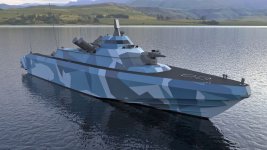I would like ULAQ better if it had hydrofoil tech, most likely faster and more agile. I don't know the downsides but it appeals to me.
Simplicity over complexity.
Ulaq is simple, easier to operate and maintain/overhaul. It has a decent speed too and the hull is capable of higher speeds with additive rear mounted engines.
Hydrofoils won't be favored in naval forces in near future due to complexity.
It can be both: it can be semi-submersible and it can get on foils when needed. Both stealth and speed can be achieved.
Sea doesn't like all in one solutions. The reason why difference between submarines and frigates are still too sharp.
I can bet Iran will loose 60-70 percent of their semi submersibles due to malfunction/lost connection/sunk before they can achieve to fire their torpedoes. And half of the remaining will fail to fire their torpedoes.
Ulaq has mounted engines which can steer without any need of a rudder, can be replaced less than half hour: however in submersible mode it would require batteries or snorkel, everything to be waterproof + additional control surfaces to maneuver and stay in a stable course and fixed engine -rudder systems.
It is sufficient if it has low as much as possible visual profile, telescopic mast and reduced rcs. (Maybe a hatch to close on top to further reduces rcs)
There is something more feasible than hydrofoil boats: swath boat with variable draft.






